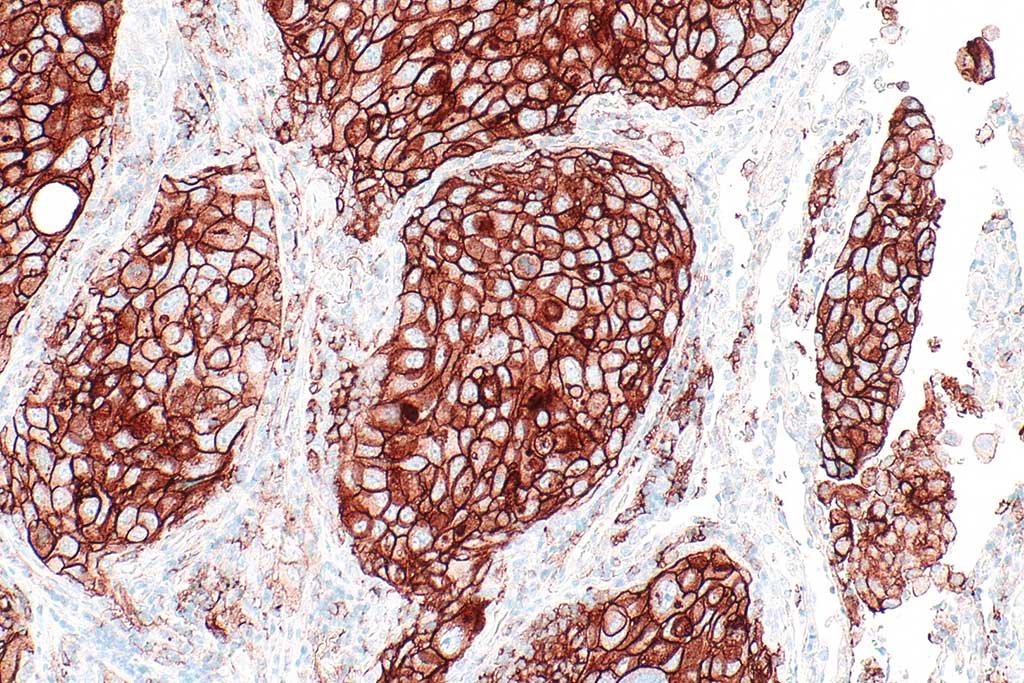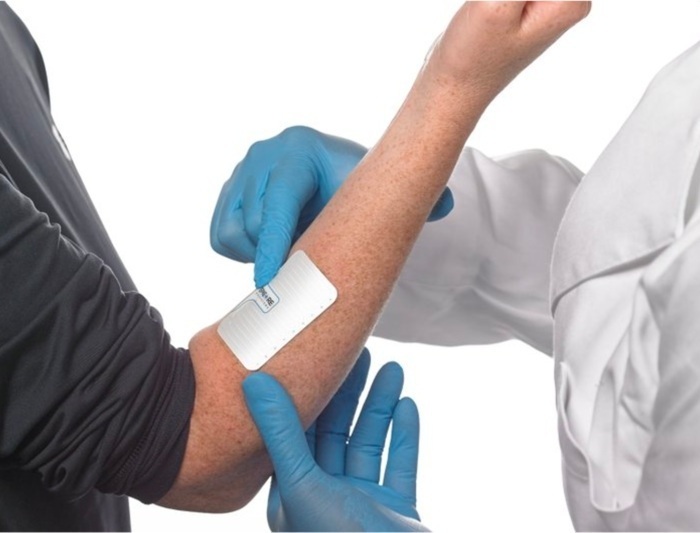Blood Test Predicts Response to Immunotherapy in Metastatic NSCLC
|
By LabMedica International staff writers Posted on 10 Mar 2020 |

Image: Immunohistological micrograph showing a programmed death-ligand 1 (PD-L1) positive non-small cell lung carcinoma (Photo courtesy of Creative Commons BY-SA 4.0/Wikimedia).
Non-small cell lung cancer (NSCLC) patients with higher measures of tumor mutations that show up in a blood test generally have a better clinical response to PD-1-based immunotherapy treatments than patients with a lower measure of mutations.
NSCLC is the most common form of lung cancer, accounting for about 84% of all lung cancer cases. In patients with metastatic disease the five-year survival rate is just 6%. Immunotherapy with a PD-1 inhibitor, either alone or in combination with chemotherapy, is the standard first-line treatment in these cases when cancers do not have a targetable mutation.
Oncologists at the University of Pennsylvania (Philadelphia, PA, USA) and their colleagues enrolled 66 patients with newly diagnosed metastatic non-small cell lung cancer (mNSCLC) starting first-line pembrolizumab-based therapy, either alone or in combination with chemotherapy. Response was assessed using response evaluation criteria in solid tumors (RECIST 1.1.) rules. Associations were made for patient characteristics, 6-month durable clinical benefit (DCB), progression free survival (PFS), and overall survival (OS).
With a simple blood draw, the scientists can screen for mutations in 500 different genes. They used this liquid biopsy panel to measure the tumor mutational burden (TMB), essentially the number of mutations detectable in the blood of the enrolled patients, 52 of whom were evaluable for the trial. TMB is typically reported as mutations per megabase (Mb), which is the number non-synonymous, somatic mutations divided by the size of the genome coding area. The median TMB was 16.8 mutations per Mb and was significantly higher for patients who experienced a durable clinical benefit (DCB) compared to those who did not. A DCB means a patient experienced a complete response, a partial response, or stable disease for more than six months. Patients who achieved a DCB had a median of 21.3 mutations per Mb, compared to 12.4 in patients who did not achieve a DCB.
The team then examined the progression-free survival (PFS) and overall survival (OS) of both groups. The 28 patients with more than 16 detectable mutations per Mb had a median PFS of 14.1 months compared to 4.7 months for the 24 patients in the lower TMB group. Median OS was not reached for the high TMB group. The low TMB group had a median OS of 8.8 months.
Erica L. Carpenter, MBA, PhD, an assistant professor and senior author of the study, said, “We believe this is the largest study to show correlation between blood-based tumor mutational burden and clinical outcomes after first-line PD-1-based treatment, including combination chemo-immunotherapy, for NSCLC.”
The authors concluded that pTMB greater than or equal to 16 mutations/Mb is associated with improved PFS after first-line standard of care pembrolizumab-based therapy in mNSCLC. STK11/KEAP1/PTEN and ERBB2 mutations may help identify pTMB-high patients unlikely to respond. The study was published on February 26, 2020 in the journal Clinical Cancer Research.
Related Links:
University of Pennsylvania
NSCLC is the most common form of lung cancer, accounting for about 84% of all lung cancer cases. In patients with metastatic disease the five-year survival rate is just 6%. Immunotherapy with a PD-1 inhibitor, either alone or in combination with chemotherapy, is the standard first-line treatment in these cases when cancers do not have a targetable mutation.
Oncologists at the University of Pennsylvania (Philadelphia, PA, USA) and their colleagues enrolled 66 patients with newly diagnosed metastatic non-small cell lung cancer (mNSCLC) starting first-line pembrolizumab-based therapy, either alone or in combination with chemotherapy. Response was assessed using response evaluation criteria in solid tumors (RECIST 1.1.) rules. Associations were made for patient characteristics, 6-month durable clinical benefit (DCB), progression free survival (PFS), and overall survival (OS).
With a simple blood draw, the scientists can screen for mutations in 500 different genes. They used this liquid biopsy panel to measure the tumor mutational burden (TMB), essentially the number of mutations detectable in the blood of the enrolled patients, 52 of whom were evaluable for the trial. TMB is typically reported as mutations per megabase (Mb), which is the number non-synonymous, somatic mutations divided by the size of the genome coding area. The median TMB was 16.8 mutations per Mb and was significantly higher for patients who experienced a durable clinical benefit (DCB) compared to those who did not. A DCB means a patient experienced a complete response, a partial response, or stable disease for more than six months. Patients who achieved a DCB had a median of 21.3 mutations per Mb, compared to 12.4 in patients who did not achieve a DCB.
The team then examined the progression-free survival (PFS) and overall survival (OS) of both groups. The 28 patients with more than 16 detectable mutations per Mb had a median PFS of 14.1 months compared to 4.7 months for the 24 patients in the lower TMB group. Median OS was not reached for the high TMB group. The low TMB group had a median OS of 8.8 months.
Erica L. Carpenter, MBA, PhD, an assistant professor and senior author of the study, said, “We believe this is the largest study to show correlation between blood-based tumor mutational burden and clinical outcomes after first-line PD-1-based treatment, including combination chemo-immunotherapy, for NSCLC.”
The authors concluded that pTMB greater than or equal to 16 mutations/Mb is associated with improved PFS after first-line standard of care pembrolizumab-based therapy in mNSCLC. STK11/KEAP1/PTEN and ERBB2 mutations may help identify pTMB-high patients unlikely to respond. The study was published on February 26, 2020 in the journal Clinical Cancer Research.
Related Links:
University of Pennsylvania
Latest Pathology News
- Accurate Pathological Analysis Improves Treatment Outcomes for Adult Fibrosarcoma
- Clinicopathologic Study Supports Exclusion of Cervical Serous Carcinoma from WHO Classification
- Mobile-Compatible AI-Powered System to Revolutionize Malaria Diagnosis
- Compact AI-Powered Microscope Enables Rapid Cost-Effective Cancer Scoring
- New Method Enables Precise Detection of Nanoplastics in Body
- AI-Powered Tool Improves Cancer Tissue Analysis
- AI Platform Uses 3D Visualization to Reveal Disease Biomarkers in Multiomics Data
- AI Tool Detects Early Signs of Blood Mutations Linked to Cancer and Heart Disease
- Multi-Omics AI Model Improves Preterm Birth Prediction Accuracy
- AI-Based Approach Diagnoses Colorectal Cancer from Gut Microbiota
- Topical Fluorescent Imaging Technique Detects Basal Cell Carcinoma
- AI Detects Early Prostate Cancer Missed by Pathologists
- AI Model Simultaneously Detects Multiple Genetic Colorectal Cancer Markers in Tissue Samples
- New Technology to Accelerate Diagnosis of Diabetic Kidney Disease
- Skin-Based Biomarkers to Enable Early Diagnosis of Amyotrophic Lateral Sclerosis
- AI Tools Analyze Kidney Disease at Cellular Level to Help Tailor Treatments
Channels
Clinical Chemistry
view channel
Gold Nanoparticles to Improve Accuracy of Ovarian Cancer Diagnosis
Ovarian cancer is considered one of the deadliest cancers, in part because it rarely shows clear symptoms in its early stages, and diagnosis is often complex. Current approaches make it difficult to accurately... Read more
Simultaneous Cell Isolation Technology Improves Cancer Diagnostic Accuracy
Accurate cancer diagnosis remains a challenge, as liquid biopsy techniques often fail to capture the complexity of tumor biology. Traditional systems for isolating circulating tumor cells (CTCs) vary in... Read moreMolecular Diagnostics
view channel
Routine Blood Draws Could Detect Epigenetic Biomarkers for Predicting Cardiovascular Disease Risk
Cardiovascular disease is a leading cause of death worldwide, yet predicting individual risk remains a persistent challenge. Traditional risk factors, while useful, do not fully capture biological changes... Read more
Single Cell RNA Sequencing Could Enable Non-Invasive Blood Disorder Diagnosis
Hematologic disorders are often diagnosed using painful, invasive, and expensive bone marrow aspiration or biopsy procedures. These approaches limit patient compliance and broader utility, leaving a need... Read more
Blood Test Identifies HPV-Associated Head and Neck Cancers 10 Years Before Symptoms
Human papillomavirus (HPV) causes around 70% of head and neck cancers in the United States, and cases are rising each year. Unlike cervical cancers linked to HPV, there is currently no screening test for... Read moreHematology
view channel
Pioneering Model Measures Radiation Exposure in Blood for Precise Cancer Treatments
Scientists have long focused on protecting organs near tumors during radiotherapy, but blood — a vital, circulating tissue — has largely been excluded from dose calculations. Each blood cell passing through... Read more
Platelets Could Improve Early and Minimally Invasive Detection of Cancer
Platelets are widely recognized for their role in blood clotting and scab formation, but they also play a crucial role in immune defense by detecting pathogens and recruiting immune cells.... Read more
Portable and Disposable Device Obtains Platelet-Rich Plasma Without Complex Equipment
Platelet-rich plasma (PRP) plays a crucial role in regenerative medicine due to its ability to accelerate healing and repair tissue. However, obtaining PRP traditionally requires expensive centrifugation... Read moreImmunology
view channel
Companion Diagnostic Test Identifies HER2-Ultralow Breast Cancer and Biliary Tract Cancer Patients
Breast cancer is the most common cancer in Europe, with more than 564,000 new cases and 145,000 deaths annually. Metastatic breast cancer is rising in younger populations and remains the leading cause... Read more
Novel Multiplex Assay Supports Diagnosis of Autoimmune Vasculitis
Autoimmune vasculitis and related conditions are difficult to diagnose quickly and accurately, often requiring multiple tests to confirm the presence of specific autoantibodies. Traditional methods can... Read more
Blood Test Predicts Immunotherapy Efficacy in Triple-Negative Breast Cancer
Triple-negative breast cancer (TNBC) is an aggressive subtype lacking targeted therapies, making immunotherapy a promising yet unpredictable option. Current biomarkers such as PD-L1 expression or tumor... Read more
Simple Genetic Testing Could Predict Treatment Success in Multiple Sclerosis Patients
Multiple sclerosis (MS) patients starting therapy often face a choice between interferon beta and glatiramer acetate, two equally established and well-tolerated first-line treatments. Until now, the decision... Read moreMicrobiology
view channel
Microfluidic Platform Assesses Neutrophil Function in Sepsis Patients
Sepsis arises from infection and immune dysregulation, with neutrophils playing a central role in its progression. However, current clinical tools are unable to both isolate these cells and assess their... Read moreNew Diagnostic Method Confirms Sepsis Infections Earlier
Sepsis remains one of the most dangerous medical emergencies, often progressing rapidly and becoming fatal without timely intervention. Each hour of delayed treatment in septic shock reduces patient survival... Read more
New Markers Could Predict Risk of Severe Chlamydia Infection
Chlamydia trachomatis is a common sexually transmitted infection that can cause pelvic inflammatory disease, infertility, and other reproductive complications when it spreads to the upper genital tract.... Read more
Portable Spectroscopy Rapidly and Noninvasively Detects Bacterial Species in Vaginal Fluid
Vaginal health depends on maintaining a balanced microbiome, particularly certain Lactobacillus species. Disruption of this balance, known as dysbiosis, can increase risks of infection, pregnancy complications,... Read moreTechnology
view channel
Coral-Inspired Capsule Samples Hidden Bacteria from Small Intestine
The gut microbiome has been linked to conditions ranging from immune disorders to mental health, yet conventional stool tests often fail to capture bacterial populations in the small intestine.... Read more
Rapid Diagnostic Technology Utilizes Breath Samples to Detect Lower Respiratory Tract Infections
Respiratory tract infections (LRTIs) are leading causes of illness and death worldwide, particularly among vulnerable populations such as the elderly, young children, and those with compromised immune systems.... Read moreIndustry
view channel
Werfen and VolitionRx Partner to Advance Diagnostic Testing for Antiphospholipid Syndrome
Antiphospholipid syndrome (APS) is a rare autoimmune disorder that causes the immune system to produce abnormal antibodies, making the blood “stickier” than normal. This condition increases the risk of... Read more


















